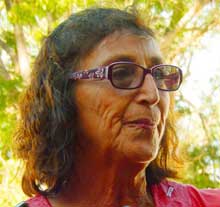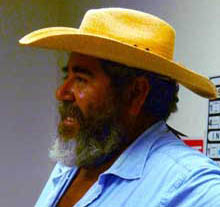Mining impacts water and health: Voices from Baja California Sur


Manuela Rivera Cota and Adolfo de la Peña Arámburo
SAN ANTONIO
To date, attempts continue to set up an open pit mining operation in the Sierra La Laguna Biosphere Reserve without first obtaining the required permits.
The plan is to create large fresh water wells for use in the mine operations. The gold they hope to extract could lead to numerous illnesses, deforestation of a large part of the area, threats to animal species, water contamination, and strong climate changes.
The Sierra La Laguna Biosphere Reserve is a protected area loaded with biodiversity, with many endemic plant and animal species. At least 17 plant species are currently considered to be endangered.
According to Jesús Quiñones, the Biosphere´s Administrative Director, the Reserve has only had changes in land use (re-zoning) approved for 101 of its 277,838 acres, the lowest rate of habitat change in the country. The rate of change is determined by comparing satellite images of the area over the years.
Manuel Aguilar, a reserve biologist, points out that among a variety of endemic and endangered species sheltered by the reserve, Mexican pinyon (Pinus cembroides subsp. lagunae) is found exclusively here.
Another notable species is the Palo de Arco (Tecoma stans var. stans) a shrub used traditionally in both hunting and house construction.
The vegetation would be wiped out in the immediate area, affecting the local hydrological cycle which plays an important role in ensuring both the supply of water and a balanced climate.
The National Commission on Protected Natural Areas refused the mining permit in a buffer zone of 865 acres, stating that because of its ecological and climatic importance as well as it being the principal source of fresh water for southern Baja California Sur, the Reserve should not be the site of a large project like Los Cardones mine.
Invecture and its subsidiary company Zapal decided to suspend further attempts to obtain the necessary permits to complete the project upon learning of the permit´s rejection in September 2014. Nevertheless, just 22 miles away, Pitalla Mining Company, a subsidiary of Argonaut Gold, is working to get a similar project underway.
This company is trying to win over the people of the small town of San Antonio by offering educational scholarships and household electronics, but so far to no avail.
There have been many demonstrations against the project. José Luis López López, doctor and member of the civil coalition Citizens Front for Water and Life (Frente Ciudadano a Favor deal Agua y la Vida) states “Contaminating the water which is needed for everyday use is too great a risk to take. Illnesses such as cancer are not things with simple solutions but rather involve a process of slow death with great suffering.
Communities such as El Triunfo and San Antonio have already been victims of past local mining. The chemicals left behind at abandoned mines have infiltrated their water supply over time, contaminating it and killing off aquatic species. For example, López adds that at the La Pitalla mine, untreated arsenic was left lying out in the open, posing a danger to the health of people living nearby and the environment.
The consequences are visible to the naked eye. In order to get clean water, the people now travel 4 kilometers or wait for the arrival of water tankers.
One of these people, Manuela Rivera Cota, housewife, craftswoman, and farmer, sells her products at the San Antonio cultural festival. Alongside other artists who offer articles made of wood from trees knocked down by the passage of hurricane Odile, and vendors of regional sweets, spices, local bread, and goat cheese, Manuela sells plants she grows at home.
They look like they have a happy life although they must struggle everyday to survive in a village with scarce resources.
She says she is witness to the effects of mining in the nearby villages. The company promised work, scholarships, household electronics, study courses, community services, and medical attention, among other things. As a result she and other villagers initially signed off in support of the mine’s placement.
Manuela and her family will never be in favor of the new mine: she explains that her 98 year old mother has to take great pains to avoid the hazards. Rivera ads that her sons are aware of the danger caused by the mining activities and are also against it.
None the less, some of San Antonio’s population are already accustomed to mining work and are in favor of the La Pitalla project.
Adolfo de la Peña Arámburo, ex miner, merchant, and farmer, has lived in San Antonio for 64 years. His children are the family’s fourth generation to be born here. After they finished school, they went to work in the mines and live in the village.
“San Antonio was founded on mining,” he emphasizes, and defends himself by saying, “our water has a high level of arsenic and we’re still alive.”
